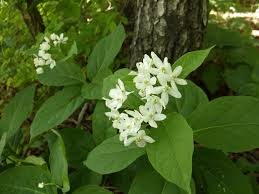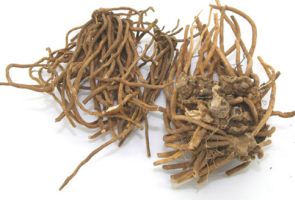 Cynanchum
atratum, stratum 白 薇 Bái wēi- "White
flowering plant" Swallowwort
root, Cynanchum Family: Asclepiadaceae
Cynanchum
atratum, stratum 白 薇 Bái wēi- "White
flowering plant" Swallowwort
root, Cynanchum Family: Asclepiadaceae
PART USED: Root- harvested Autumn (best) and Spring.
FUNCTIONS
GROUP: Clearing Internal Heat- Cool Blood
1. Cleat Heat, cools Blood.[4]
2. Stimulates salivation to supplement energy.[1]
3. Stops coughing.[1]
4. Promote urination.[4]
5. Relieves toxicity.[4]
ACTIONS
INDICATIONS- Mostly used in gynaecological disorders.[3] Bai wei assistant herb in cooling Blood.[3] Used mostly for treating Heat deficient conditions.[3]
1. Heat entering the Blood with Yin deficient fever.[1,4] Tuberculosis.[1] Fever, fainting due to Blood deficiency. Post partum fever: can use with other Yin tonic herbs for deficient Heat condition.[3,4] Afternoon fever.[3] Persistent Summer time fever in children. Chronic fever after febrile disease that injures Blood or Yin.[4]
2. Urinary tract infections Nephritis, urinary tract infections, edema.[1] Hot or painful urination dysfunction, especially before or after giving birth.[4]
3. Body weakness, seminal emission, leukorrhea and other ailments seen during convalescence.[1] Incontinence- pre or post natal.[3]
4. Toxic sores, swollen and painful throat, and snakebite- injested or aplied locally.[4]
PATENT COMBINATIONS
- Febrile illness due to exterior Wind Heat or Heat and Toxicity: Clear Heat and resolves Toxicity, releases exterior Wind Heat Isatis & Forsythia- Xiao er tui re chong ji.
COMBINATIONS
PREPARATIONS: Decoction. Roots and tuberous stems 9-15 g.[1] Root and tuberous root 4-9 g.[2,3] 6-15 g.[4] Dry root.[3] Good quality is long, thick, strong, and a yellowish brown color.

 HABITAT:
Grows mostly on hilly slopes, thickets in waste places or along forest edges.
HABITAT:
Grows mostly on hilly slopes, thickets in waste places or along forest edges.
DESCRIPTION: An erect perennial herb. Fibrous roots numerous, fragrant, easily broken when dried. Stems; erect, cylindrical, densely covered by fine white hairs. Leaves; opposite, broadly ovate, apexes acute, bases broadly cuneate, margins intact, both sides finely pubescent. Flowers; in summer, apical or axillary purplish black flowers clustered. Fruit; a follicle.
References
Inner Path can not take any responsibility for any adverse effects from the use of plants. Always seek advice from a professional before using a plant medicinally.
Research
Protective activity of the ethanol extract of Cynanchum paniculatum (BUNGE) Kitagawa on treating herpes simplex encephalitis.
Li XF, Guo YJ, Zhang DM, Chen Z, Wei X, Li YH, Zhang SL, Tao JY, Dong JH, Mei YW, Li LL, Zhao L.
Abstract
To date there has been no valid treatment for herpes simplex encephalitis (HSV). This study explores the protective activity of ethanol extract of Cynanchum paniculatum (bunge) kitagawa for treatment of HSV. Cell models and animal models were established and divided into 4 groups: normal group, virus group, cynanchum paniculatum group and Dexamethasone group. Flow cytometry was employed to detect apoptosis of cell model and TUNEL assay was chosen to detect apoptosis of animal tissues. The survival time of the animal models was observed. ELISA was used to measure TNF-alpha expression and the Greiss method to measure Nitric Oxide (NO) expression in the mouse brain. As a result, it was found that extract of Cynanchum paniculatum can improve the survival rate of HSV-infected mice. The extract could prevent apoptosis in the neuron cell model and reduce apoptosis rate in brain tissue after HSV infection. With the extract intervention, TNF-alpha and NO levels in brain tissue were significantly decreased in the animal model. In conclusion, the extract of Cynanchum paniculatum can prevent HSV-inducing impairment in the cell and animal model of HSE. Int J Immunopathol Pharmacol. 2012 Jan-Mar;25(1):259-66. ncbi.nlm.nih.gov
Bioactive constituents of the roots of Cynanchum atratum.
Day SH, Wang JP, Won SJ, Lin CN.
Abstract
A novel biphenylneolignan, 2,6,2',6'-tetramethoxy-4,4'-bis(2,3-epoxy-1-hydroxypropyl)biphenyl (1), and two new glycosides named atratoglaucosides A (2) and B (3), were isolated from the roots of Cynanchum atratum, and their structures were determined on the basis of chemical and spectroscopic evidence. The aglycons of 2 and 3 were identified as glaucogenin C and 7-desoxyneocynapanogenin A, a new disecopregnane. A known compound, glaucogenin C 3-O-beta-D-cymaropyranosyl-(1-->4)-alpha-L-diginopyranosyl-(1-->4)-beta-D-thevetopyranoside (4), isolated from the same source, showed a significant cytotoxic effect against 212 cells. This substance also gave a significant inhibitory effect on TNF-alpha (tumor necrosis factor-alpha) formation from the RAW 264.7 mouse macrophage-like cell line stimulated with LPS (lipopolysaccharide) and on the N9 microglial cell line stimulated with LPS/IFN-gamma (interferon-gamma).
PMID: 11374953 J Nat Prod. 2001 May;64(5):608-11. ncbi.nlm.nih.gov
Cytotoxic and apoptosis-inducing activity of C21 steroids from the roots of Cynanchum atratum.
Zhang J, Ma L, Wu ZF, Yu SL, Wang L, Ye WC, Zhang QW, Yin ZQ.
Abstract
Two new (1-2) and two known C21 steroids (3-4) were isolated from the roots of Cynanchum atratum. Their structures were elucidated by detailed 1D and 2D spectroscopic. The MTT assay showed that compounds 1-4 displayed obvious cytotoxic activities against HepG2 cells with IC50 values ranging from 10.19μM to 76.12μM. Compounds 1-3 also exhibited cytotoxic effects in A549 cells with IC50 values of 30.87-95.39μM. Compound 3 showed the antiproliferative activity via G0/G1 cell cycle arrest and proapoptosis in HepG2 cells by Flowcytometry analysis. Western blotting analysis revealed that compound 3 could induce HepG2 cell apoptosis via the mitochondrial pathway by downregulating Bcl-2 expression, upregulating Bax protein expression, and activating caspase-9 and caspase-3.
PMID: 28327355 DOI: 10.1016/j.steroids.2017.03.004 Steroids. 2017 Jun;122:1-8. doi: 10.1016/j.steroids.2017.03.004. Epub 2017 Mar 19. ncbi.nlm.nih.gov
Cynanchum atratum inhibits the development of atopic dermatitis in 2,4-dinitrochlorobenzene-induced mice.
Choi YY, Kim MH, Lee H, Ahn KS, Um JY, Lee SG, Kim J, Yang WM.
Abstract
Cynanchum atratum Bunge (Apocynaceae) is a folk medicine to treat skin inflammatory diseases. However, the effects of C. atratum on atopic dermatitis have not been elucidated. In this study, we evaluate the effects of aqueous extract of C. atratum (CA) and its molecular mechanism on atopic dermatitis (AD). 1 and 100mg/mL CA were topically applied to 2,4-dinitrochlorobenzene (DNCB)-induced AD-like skin lesions for 11 days. The number of scratching behavior was evaluated for 20min. AD-like symptoms including elevated serum IgE, skin hyperplasia and mast cell infiltration were investigated. The expressions of pro-inflammatory cytokines and mediators were analyzed in AD-like skin legions. In addition, pro-inflammatory cytokine production was confirmed in human mast cells (HMC)-1 stimulated with PMA plus A23187 (PMACI). Topical application of CA attenuated total serum IgE level and scratching behavior. Skin hyperplasia including epidermis and dermis was ameliorated in CA-treated skin legions. The number of infiltrated mast cells was significantly decreased by CA treatment. In addition, CA reduced pro-inflammatory cytokines, such as IL-6, IL-1β and TNF-α and Th2 cytokine, IL-4, in both of AD-like skin lesions and PMACI-sensitized HMC-1 cells. Furthermore, CA decreased the expressions of NF-κB, phospho-IκBα and MAP kinase. These results suggest the inhibitory effects of CA on the development of AD by regulating pro-inflammatory cytokines and mediators. CA could be an effective substance for the treatment of AD.
PMID: 28365521 DOI: 10.1016/j.biopha.2017.03.065 Biomed Pharmacother. 2017 Jun;90:321-327. doi: 10.1016/j.biopha.2017.03.065. Epub 2017 Mar 30. ncbi.nlm.nih.gov